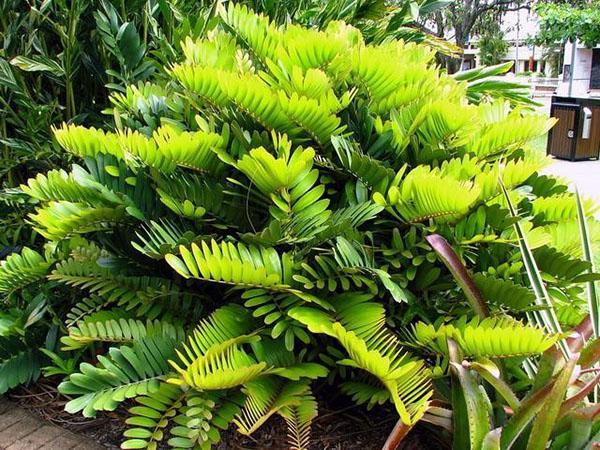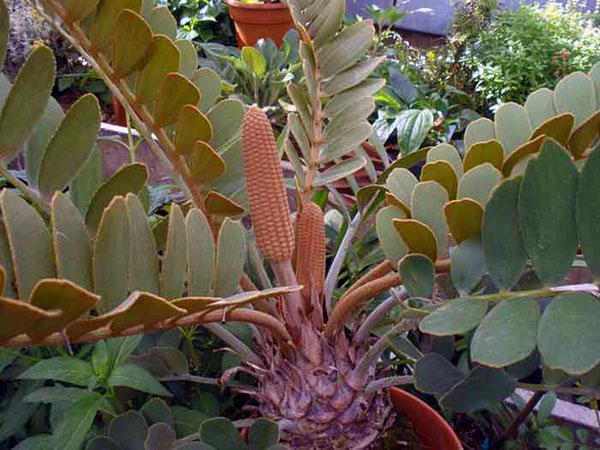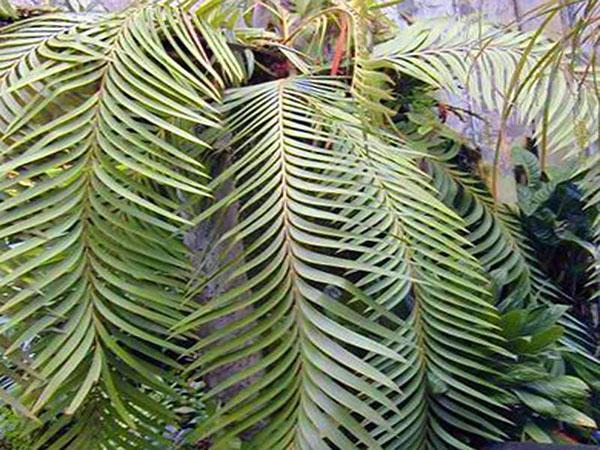Home care
 Zamia is a family of evergreen plants. Naturally, this flower grows in tropical and subtropical regions of America, it can also be grown at home in a pot. He does not grow very large, but requires special conditions of detention. Even with good home care, zamia almost never blooms, but it looks original.
Zamia is a family of evergreen plants. Naturally, this flower grows in tropical and subtropical regions of America, it can also be grown at home in a pot. He does not grow very large, but requires special conditions of detention. Even with good home care, zamia almost never blooms, but it looks original.
Characteristics and varieties of plants

- Zamia pseudoparasitic is a large tree that naturally grows up to 3 m in height. The leaves reach 2 m, they have elongated leaves up to 30-40 cm each.

- Powdered zamia got its name because of the unusual color of the leaves. They are oblong, and there are light scales on their surface. The trunk is almost completely hidden under the ground, it can only be seen in adult flowers.

- Broad-leaved zamia is a short plant with an underground or aboveground trunk. The leaves are large, rounded leaves.

- Dwarf zamia is a variety that is perfect for growing at home. The trunk is underground, reaching 25 cm in length in adult plants. The leaves are collected in a rosette and can grow up to 50 cm.

All varieties of this plant are poisonous to humans and animals. In cats and dogs, they cause allergic reactions and dermatitis.
Home care rules
 A suitable species should be chosen not only by the photo of zamia flowers, but also by their conditions of detention. They can be grown in pots at home, but it is important to create comfortable conditions for them that are as close to natural as possible. At home, the flower will not multiply, since the only way to propagate it is with seeds.
A suitable species should be chosen not only by the photo of zamia flowers, but also by their conditions of detention. They can be grown in pots at home, but it is important to create comfortable conditions for them that are as close to natural as possible. At home, the flower will not multiply, since the only way to propagate it is with seeds.
Temperature and illumination
 Zamia is used to growing up in well-lit areas, so she needs to organize such conditions at home. Place the pots on windowsills on the sunny side. However, on very hot days, it is better to rearrange the plant in the shade. The leaves of this flower grow in the form of a rosette, so it is important to turn the pot in different directions towards the sun. So they will be the same size and color.
Zamia is used to growing up in well-lit areas, so she needs to organize such conditions at home. Place the pots on windowsills on the sunny side. However, on very hot days, it is better to rearrange the plant in the shade. The leaves of this flower grow in the form of a rosette, so it is important to turn the pot in different directions towards the sun. So they will be the same size and color.
All varieties of zamia are heat-loving plants. The most comfortable temperature for them is 25-28 degrees, and in winter it should not drop below 15 ᴼС. The room must be ventilated, but the container with the flower should not stand in a draft. From time to time, the leaves can be wiped off dust with a sponge.
Excessive sun exposure can cause leaf burns if the plant is not gradually prepared for these conditions.
Requirements for soil and watering
 Caring for a houseplant with a zamie is not difficult. It grows well on all types of soil; a regular store substrate is suitable for planting it at home. You can also prepare it yourself from the following components:
Caring for a houseplant with a zamie is not difficult. It grows well on all types of soil; a regular store substrate is suitable for planting it at home. You can also prepare it yourself from the following components:
- clay as a base - 4 parts;
- peat - 2 parts;
- humus - 2 parts;
- sand - 1 part.
In the summer, the flower must be watered constantly, preventing the topsoil from drying out. The water should be at room temperature or slightly warmer, but not hot.In autumn, watering is gradually reduced, and in winter it is enough to water the flower once every 3-4 weeks. You also need to monitor the condition of the plant. If its leaves begin to turn yellow and fall off, it means that there is not enough moisture.
Diseases and pests
 With proper care, the flower grows healthy. For prevention, it does not need to be processed with anything. If the plant does not feel comfortable enough, this can be understood by the following symptoms:
With proper care, the flower grows healthy. For prevention, it does not need to be processed with anything. If the plant does not feel comfortable enough, this can be understood by the following symptoms:
- with too much watering in combination with nitrogen fertilizers, the root may begin to rot;
- in conditions of too wet soil, when the air temperature drops, the flower may die;
- sunburns look like leaf pigmentation disorders;
- parasites (spider mites, aphids and scale insects) may also appear, feed on the juices of the flower and can lead to its death.
At home, it is easy to grow a zamia and take care of it, just keep it warm and water it regularly. It grows slowly, so an adult plant is transplanted no more than once every 5 years. However, pet owners are not advised to have this flower as it is poisonous. The poison is found in leaves and stems and can be poisoned by cats. It causes a common allergic reaction that is manifested by skin rashes, irritation, itching and hair loss.